Serenity, I would say. Faith and spirituality that's what would other say.



Animism and the worship of ancestors have a very important weight in the Balinese life, even in the Hindu observance of local, to such an extent that we as Westerners came to think that they don't do anything but pray, and that one half of a market stalls, for instance, are dedicated to offerings to the gods.A Balinese friend talked to me about the term sekala- niskala which would mean visible-invisible and which includes the idea that the physical world, that we can feel and touch goes through a spiritual world. Spirits (gods and demons) are honoured with offerings of flowers and food and elders are divinized in complex rituals.



The beauty of the landscape and the position of certain energy points were essential to decide the place to build a temple.It is the case of the Taman Ayun in Mengwi, a city in passing, without further cultural interest, but full of great spiritual power, since as it is believed, to be in the axis linking the mountains with the Sea that provides the harmonic flow of water from the mountains to the rice fields, then to the sea and back to the mountains.


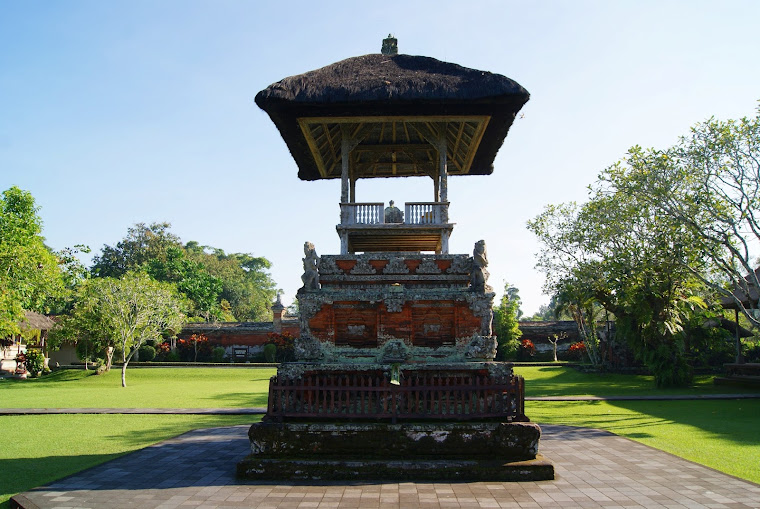


Surrounded by moats which symbolize the Hindu world on the cosmic sea, meru towers represent the mountains, homes of the gods, and some shrines shaped in pavilions are covered with a special honour, like one of them with the throne of Lotus where the Hindu gods Shiva, Brahma and Vishnu sit during the ceremonies.




All this can be admired and enjoyed with all respect, as always, from a walk that surrounds all of the sacred Temple, since the entrance to the interior is not permitted.








We can, anyway, admire the jewel of the set, the Kori Agung or front door with a curious relief of the Sai guardian gods, prophets and guardian figures from Balinese mythology. It only opens its doors during the ceremonies, but away from the heart of the temple, I dare to recommend the walk around that see it from the open door.







The temple is located between two streams of water, which makes the set an idyllic spot.
 Next visit was Marga.
Next visit was Marga.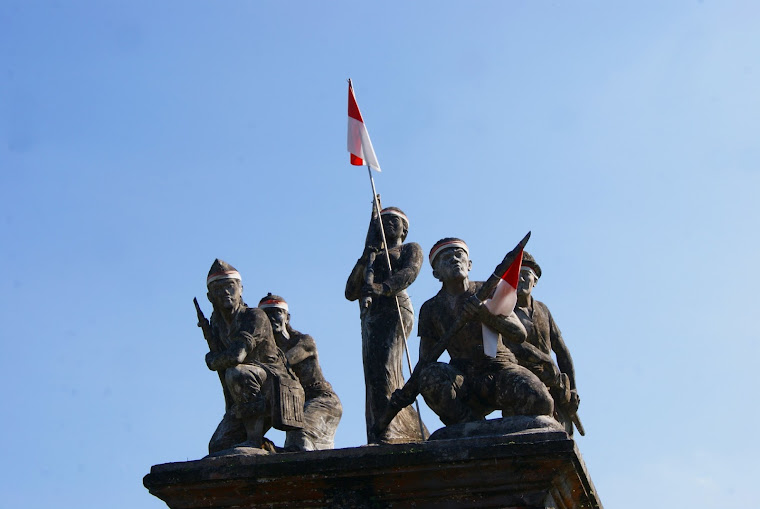

It was really difficult to find the site, maybe because the name is not the official in the local dialect or because it is a little away from the villages.


What is certain is that it worths the detour off the main road to find us just in front of the memorial complex.

Once parked the car under a big ceiba tree, we walked to the entrance. Around there are no houses, the site occupies a place, on a plain, of a battle between the Dutch and the balinese guerrillas, which took place in 1946. The nearest houses belong to a village at the East of the place, which is what gives name to the area, Marga.










When we enter, we see the monument of Margarana, surrounded by the tombs of the 94 guerrilla who fell in the battle of Marga. After passing through the beautiful garden with several pavilions surrounded by a moat with carps and catfish,we find the symmetry of the monuments, the tombs of 1372 fallen of the 1940s independence war heroes. The tombs have nothing to do with the Hindus, since they are small meru-shaped structures that recall the ancient temples of the Javanese Majapahit Empire.
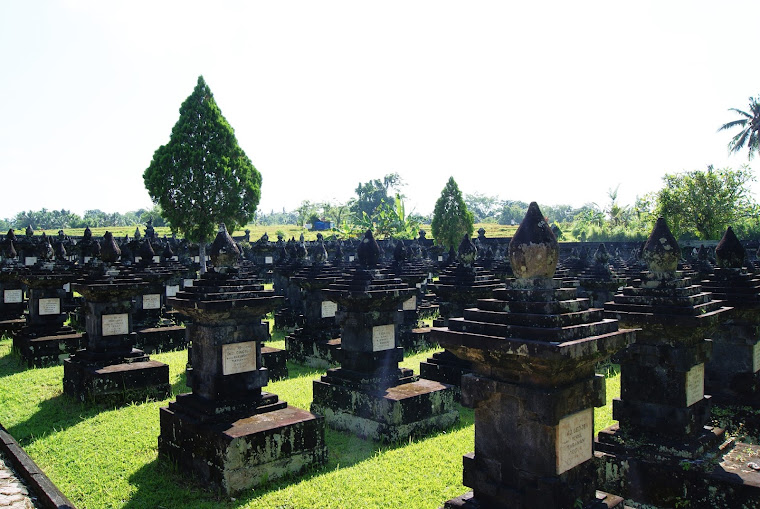
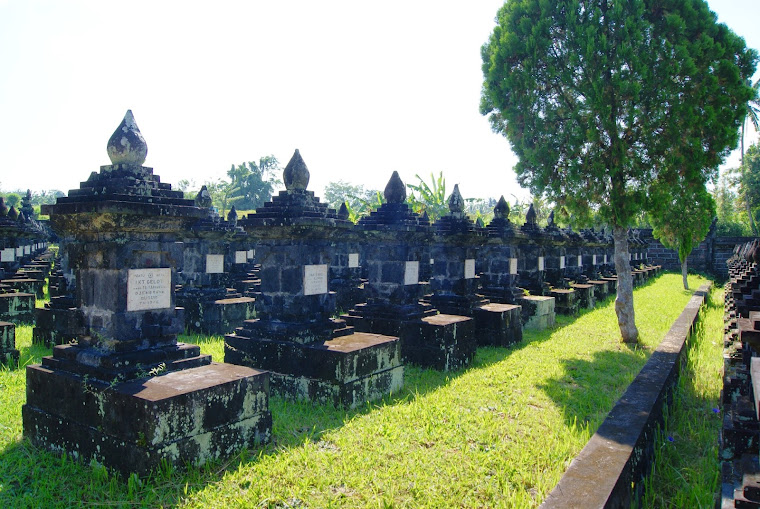

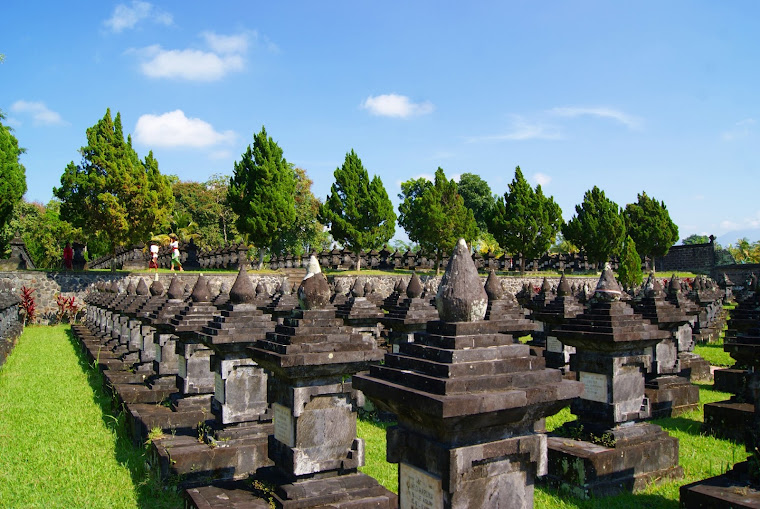




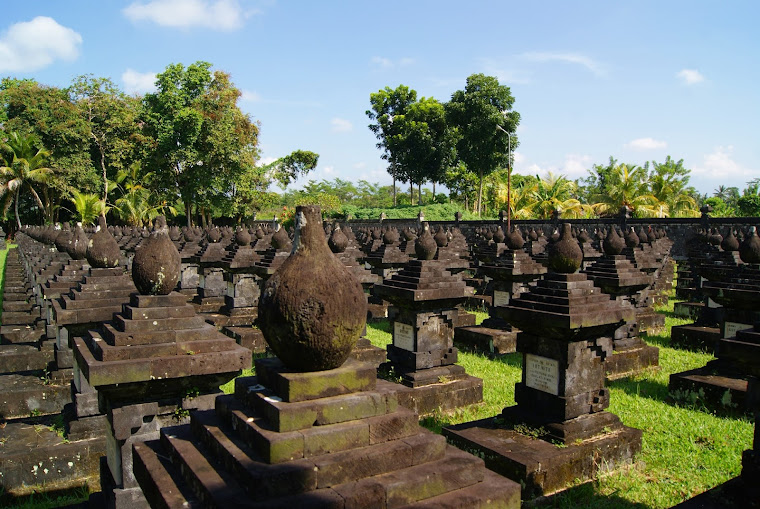
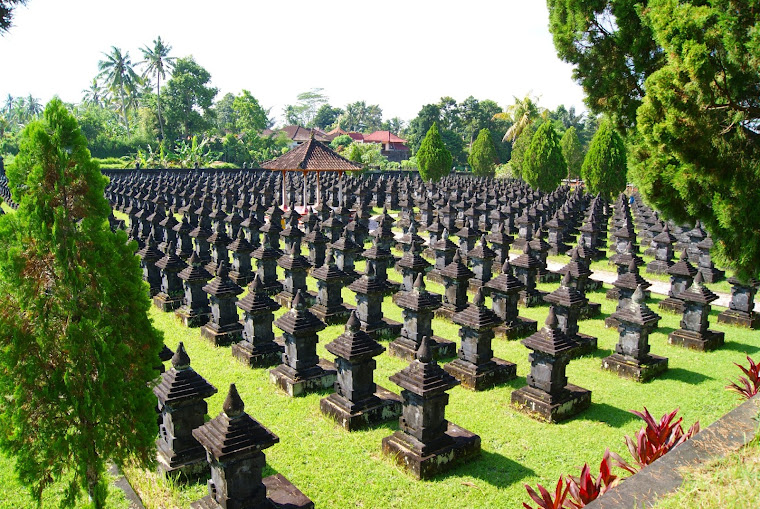



It was at that point when I lived one of the most moving moments of my life. While I took pictures of the graves, a family was making offerings to their father and husband. Seeing that I kept at a safe distance, observing, they looked towards me and invited me to come and place myself on their side. With all my respect, I attached my sarong and knelt next to them. I was invited to eat the offerings of the dead, one of the highest honors that a strange can receive. They even allowed me to photograph them at their time of greater intimacy, in its communication with the deceased.





There, I understood the Balinese friendly soul, simplicity and their love. But we had to go on, so my steps took me to the central monument, where a communal bid was taking place. This monument cannot be confused with a meru Balinese shrine, because this one was designed to symbolize the day of the proclamation of Independence on August 17, 1945. Four steps and five small columns of the base represent the year (45), eight roof heights, the month (August) and the total height, 17 meters, the day. Symbolism, faith, harmony... tribute to those who fought to the end of their lifes for their country.




Marga is well worth a visit...And we follow the road to the North

Sabía que cuando llegara el momento de escribir sobre Pura Ulun Danu Bratan tendría un choque de sentimientos.
Antes de ir a Bali, decenas de años antes, la imagen mágica que tenía de la isla se resumía prácticamente en la visión de este templo flotando sobre las aguas del Lago Bratán. Una imagen entre espiritual y rural, alimentada por guías de viaje y revistas obsoletas y caducadas con un aire de rancio romanticismo.




Al llegar, un mini parque de atracciones sacudío mi recuerdo.
Primero, una arquitectura de alta montaña que como si de una suiza oriental se tratara, gobierna e invade todo el perímetro del lago; un parking organizadísimo, que cual IKEA te obliga a pasar por todos los puestos de venta de recuerdos y demás inutilidades hasta que, después de pagar una entrada accedemos al recinto por un jardín cuidado con todo esmero y detallismo.
En los muelles del lago varios negocios: alquiler de paracadas con motora, esquí acuático, barcas y guías para ascender a pie hasta los picos.

Y por fin aparece el templo, restaurado hasta la saciedad, embellecido al gusto oriental que tanto nos atrae a los occidentales, pero sin ese tono sepia, decadente que tenía en mi recuerdo.



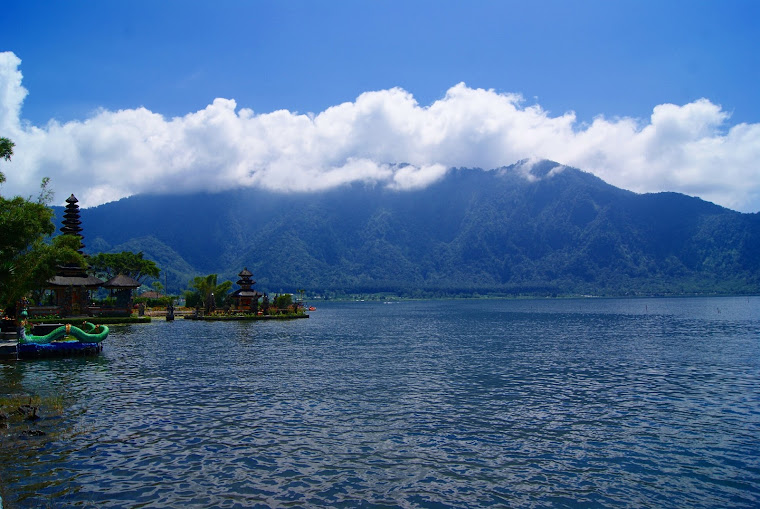




Vuelta de tuerca. Estoy aquí guardo esa imagen en la mente y percibo la actual, la que me enseña un templo del siglo XVII, no más antiguo, que hasta hace poco era propiedad exclusiva de las cañas y las percas del lago, pero al que su fotogenia ha cambiado la vida.


No menos se merece Danu, la diosa del lago, ni Buda, que tiene una pequeña stupa con varias imágenes suyas orientadas hacia los puntos cardinales.
La imagen, lo reconozco, sigue siendo inolvidable, mantiene un poquitín de magia, un resquicio de la que permanece en el fondo de mis recuerdos.
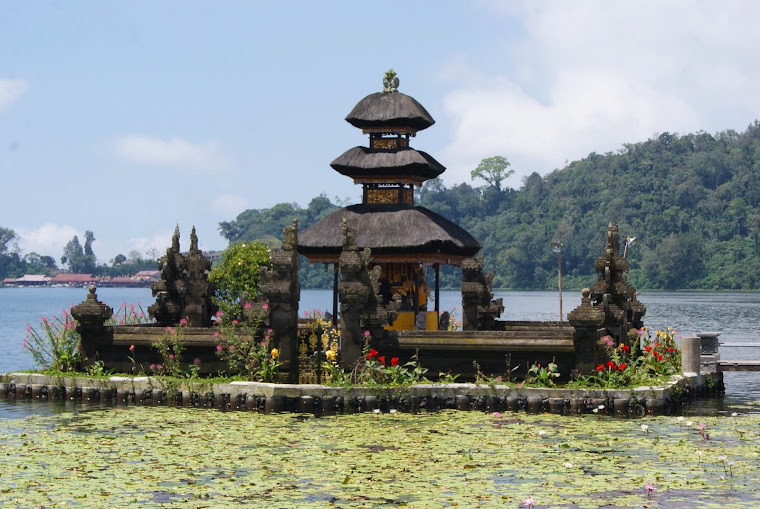


Intentaré juntar las dos sin eliminar ninguna. El tiempo pasa y las imágenes de hoy se volverán sepia...
After visiting the touristic Temple of Danu, precious, of course, but which continues to be a magnet for visitors and a "must" when visiting Bali, I recommend to follow the road that parts from the car park and go on drivind for a few kilometers, and when we see a beautiful expanse of water, stop the car in that quiet and peaceful place.


That is Buyan. The water of the lake reflecting mountains that have fond that hikers from around the world, the stillness that seems to permeate the enclave, where the water dares not to make a noise.Behind us a small temple, not as nice as the previous, perhaps less romantic, but also home to the spirits of the water.


People come to fish, to talk or just to spend the evening. It does remember me the alpine landscapes of Switzerland or the nearest Nepal.



Let us enjoy the place for long a long time before taking the way again...to Gitgit.
This has been without doubt one of the most entertainingcrners in the trip of Bali, since it was a big amount of feelings in a little less than an hour.To get to the waterfall of Guiguit we should get out of the main road that runs through the island from north to south. 400 metres from the entrance of the road there is a small car park and a station where "we must" make a "donation", with the clear difference between our sense of donation and theirs.


A trail leads us through the towering trees until a couple of houses where the road forks.

DON'T take that one indicated by the arrow (as we did), because it is warped and leads to some endless staircases that took us down a ravine where the water flows wild and there is a kind of turbine and several waterfalls, but inaccessible. The site is very nice but climbing again the stairs, killed us.



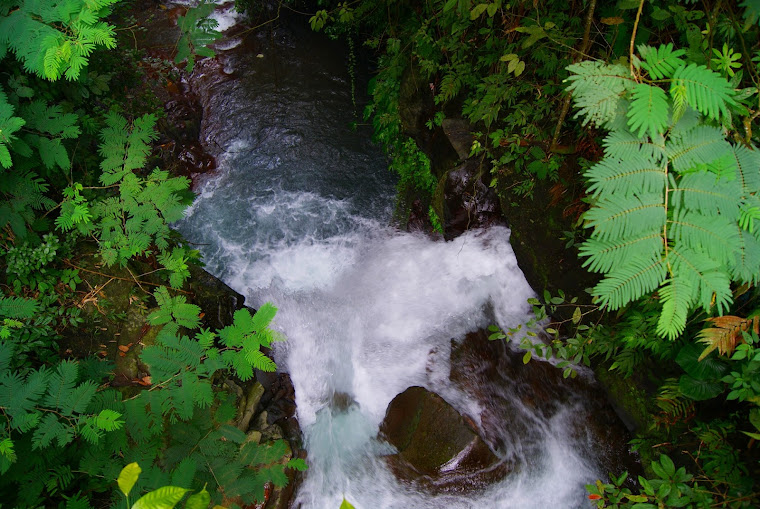

So in the fork we continue straight, by the road covered with cement and at 200 metres we reach a really unique place, where alternate several waterfalls with pools where you can swim calmly, in a water so clean that I even dared to drink it. It was sweet and fresh...



Children enjoyed the water in such a way that we could not be less and we dived on it.The force of the water sweeped us along in some places, but it was part of the fun. A precious altar was the ideal complement in the image of the water falling from the high walls of the ravine. It was like a closed space, where it had arrive virtually nothing, where nature enveloped everything and at the same time seemed to want to burst in colours, sounds and scents.

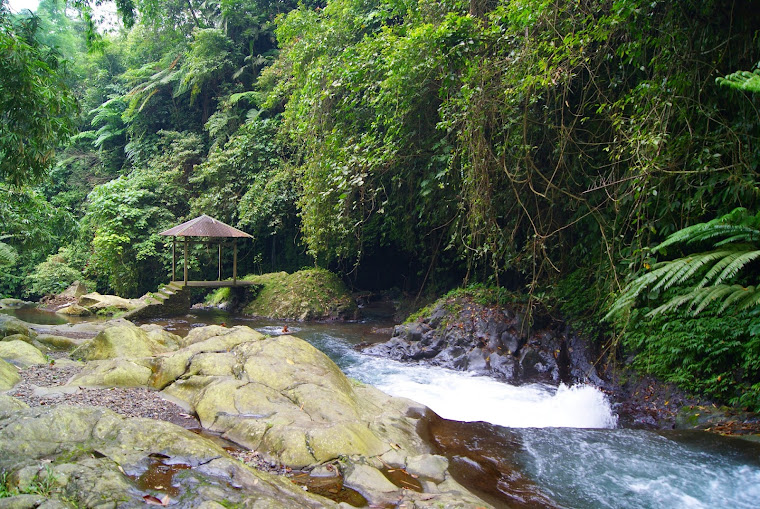








Refreshed, relaxed and with new energies we continued our way north.
Singaraja remained in our plan as an interesting place, without much to do but with some other attractions.Upon arrival, the intense heat forced us to reduce the visit almost to two blocks, the entrance to the city and a pedestrian walk to the old pier.

It attracted our attention for its mosques by the seashore, its temples and its market, that would be a pleasant place for a walk, if it weren't for the sweltering heat.So we decided to take a quick look at the river Buleleng, heritage of the communities of Chinese merchants houses and that resemble their country of origin, and in the same way an outside visit to the Chinese temple, with the classic red-tiled and decorated with gilded calligraphy panels, also paid by Eastern traders.




In this picture, the advertisement of a dentist.....

And thus we reached Air Panas. If one thing strucked me in Bali, it is that all places of visit, both tourist and for the Balinese, have a parking nearby, of course with their corresponding carer who gives us our proof of payment, always ranging between about 2,000 and 3,000 rupees (0.15 and 0.25 cents) that makes you save time to find parking and being asked by the "wise carer" for a tip, as in many other parts of the world.So we leave the mobile, as they call the car and walked between posts of sarongs, t-shirts of Bintang, flowered Bermuda and after passing an arch and a bridge over a tiny ravine we arrived to the place.


This resort, very popular for locals and visitors from the nearby Lovina, has three swimming pools; the highest has thermal water. In its eight heads of dragon hides the pipes from which emanates a yellowish green sulphurous water which is apparently therapeutic for diseases of the skin. The locals consider sacred that hot water: it has been built a temple around the spring that occupies a cool and shaded location. If we are not wearing bathing suit, there are a few booths, free, which we can use to change before and after the bath.
It is always an honor to share customs and usages with the inhabitants of the countries that I have visited and in just one minute we were enjoying the sacred water. And finally, nothing better than a bag-shaped banana leaf filled with rice and a mix of chicken, peanuts, and of course, lots of sambal (spicy sauce).

And about rice we can talk long and hard, mountain lakes, the mild climate and rich volcanic lands of Bali are suitable for cereal cultivation.


Although part of farmland is earmarked for other uses, irrigation paddy fields remain as fertile dominant rural landscape, and worship and farming of rice have hardly changed since the Neolithic. The rugged terrain makes mechanization and poses problems for growing through flood, since the water flows well below the topsoil, at the bottom of deep gorges. The solution adopted by the Balinese is an ingenious system of canals tunnels and irrigation aqueducts that divert water from mountain springs to farming communities.


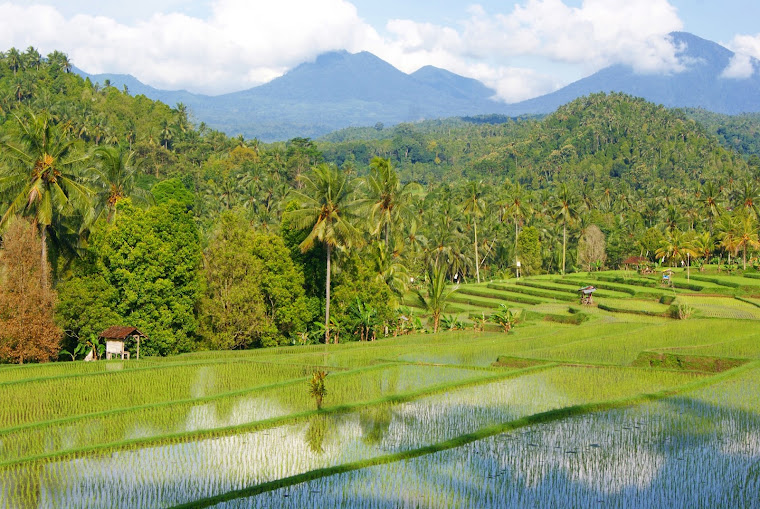

But all this would not be possible without the blessing of the goddess of rice, who has to be worshiped with offerings from the time of planting to the harvest.





Like everything else, in Bali, it needs spiritual protection and thanksgiving for a land so fertile and generous.And after this paradisiacal landscape, we returned home to have a rest...
No hay comentarios:
Publicar un comentario